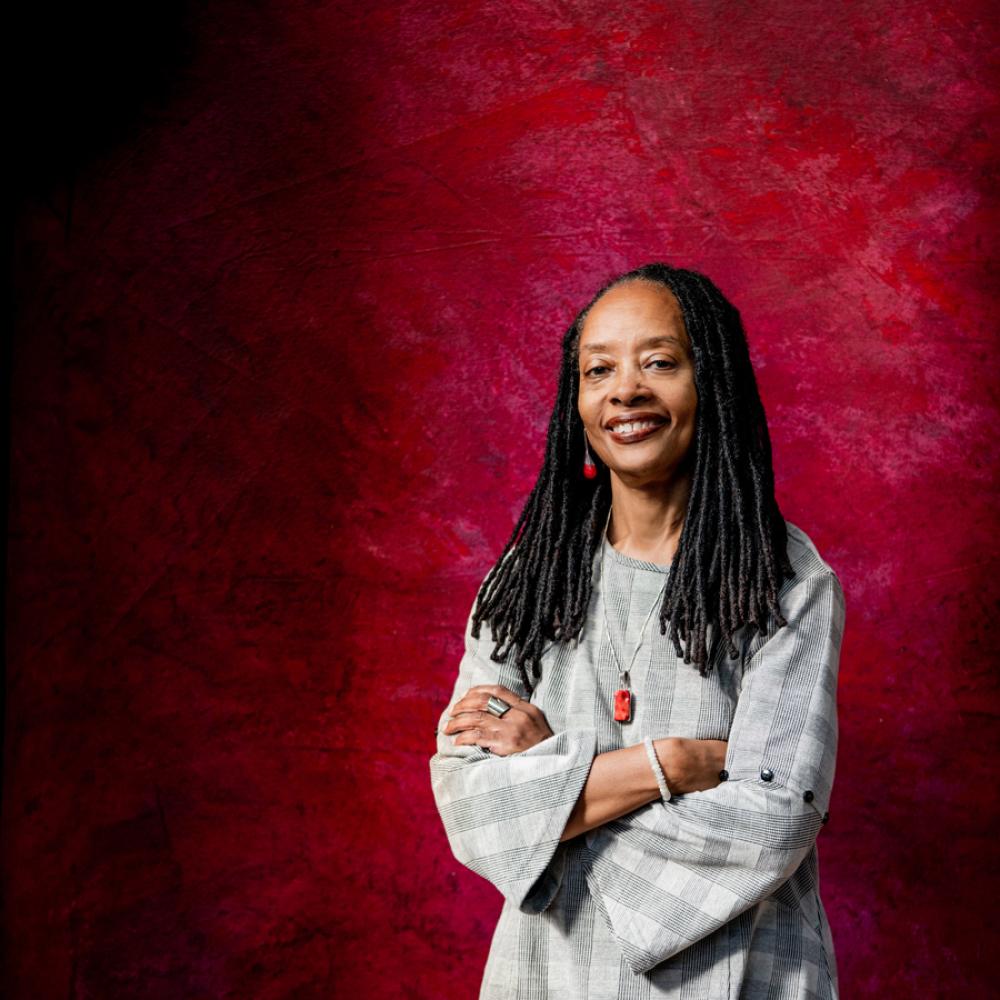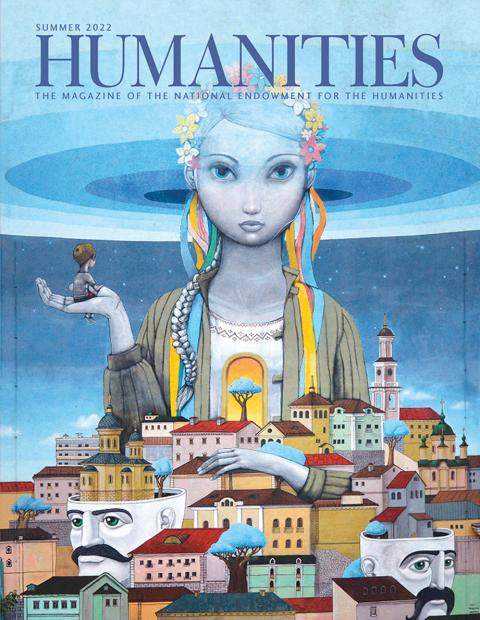“Diving into Zora’s life in a deep, substantive way gave me a greater appreciation for the sweetness and the fragility of life, helping me to see the importance of using my time wisely and of living joyfully.” —Valerie Boyd
Valerie Boyd—writer, editor, educator, and biographer—died at the age of fifty-eight on February 12, 2022. She was, to quote an old hip-hop lyric, “something like a phenomenon,” thanks to her award-winning 2003 biography, Wrapped in Rainbows: The Life of Zora Neale Hurston, which writer and novelist Alice Walker declared, “Will be the standard for years to come.”
Describing her literary philosophy on the website Chip on Your Shoulder, Boyd said that “the most important lesson I’ve learned as a storyteller—as both a writer and an editor—is to be quiet enough to let others speak. Even if I am the narrator, or the lead storyteller, every character has a story, every person in the room has a voice—and every story deserves space to unfurl, every voice deserves a listener. My job is to listen, to amplify, to synthesize, to distill.”
Among Boyd’s publications is Gathering Blossoms Under Fire: The Journals of Alice Walker, 1965–2000, a collection of Walker’s writings on a variety of subjects that she edited. Boyd’s final book, Bigger Than Bravery: Black Resilience and Reclamation in a Time of Pandemic, which deals with African Americans writing during the pandemic, is scheduled for release this fall.
Boyd was a literary institution in her hometown, Atlanta. She was the valedictorian of C. L. Harper High School, where she ran the student newspaper. In the early nineties, she published two magazines: EightRock, a groundbreaking literary journal that featured profiles on a diasporic panorama of Black artists, including Afrofuturist writer Samuel Delany, filmmaker Haile Gerima, and vocalist Cassandra Wilson; and HealthQuest (co-published by Sara Lomax-Reese), which covered news about standard and alternative medicine for the African-American community. Boyd worked also as an editor for the Atlanta Journal-Constitution and contributed articles to the Oxford American, Essence, and Atlanta Magazine.
An educator and a humanist as well, Boyd was a graduate of Northwestern University’s Medill School of Journalism, where she had earned her bachelor’s degree in 1985. In 1999, she received an MFA in creative nonfiction from Goucher College. And at the time of her death, she was a professor of journalism and the Charlayne Hunter-Gault Distinguished Writer in Residence at the University of Georgia, where she founded and directed the MFA program in narrative nonfiction.
Boyd was an example, too, of the writer-scholar types who make vital contributions to humanities programming across the country. Boyd made a difference in Florida, especially, teaching a series of NEH summer seminars entitled “Jump at the Sun: Zora Neale Hurston and Her Eatonville Roots” from 2008 to 2013, and again in 2017. The seminars were held in Hurston’s all-Black hometown, a place that provided Hurston with the affirmative, rich, cultural pride and resilience to write her celebrated literary and anthropological works, including Dust Tracks on a Road, Tell My Horse, and her masterpiece, Their Eyes Were Watching God. Produced by Florida Humanities and funded mostly by the National Endowment for the Humanities, the seminars, which were held on the campus of Rollins College, brought together dozens of primary and high school teachers from Florida and beyond to attend master classes taught by scholars on Hurston’s life and art.
Ann Schoenacher was the director of the Florida Center for Teachers and was part of the team that created the workshops for K–12 Florida educators. “After FHC had conducted a couple of weeklong workshops on the Harlem Renaissance, we decided to focus on Zora Neale Hurston, because of her strong connection to Florida,” Schoenacher wrote in an email. “So we developed a grant proposal to the National Endowment for the Humanities through their Landmarks of American History and Culture grants to create a weeklong workshop, which explored the impact of place (specifically, Eatonville), on Hurston’s life and work.”
“We thought Valerie would be absolutely the most magnificent person to present at the seminar,” says Janine Farver, former Florida Humanities executive director. “From almost the first seminar, Valerie turned those teachers into ‘Zora Heads,’ a term I think she coined, like Dead Heads,” Farver says, referencing the devoted followers of the band the Grateful Dead. “She just completely infused the teachers with this fascination with Zora. She had them in the palm of her hand. Many teachers came to these conferences with some knowledge or appreciation of Zora, but by the time they left, they were just exploding with ideas and enthusiasm.”
One of those “Zora Heads” was Gulleta (Jan) Britt, who is currently a second-grade teacher at Morningside School in Port St. Lucie, Florida. She had never heard of Hurston before signing up for the workshop, even though she was born in Fort Pierce, where Hurston died in poverty and obscurity in 1960. “I wanted to know who this Zora Neale Hurston from Fort Pierce was,” Britt remembers. “The information that Dr. Boyd presented to us in 2009, I presented verbatim to my students: I didn't have to read from a book because of how she presented [Hurston]. She blew my mind.”
According to Stephania Perkins Biddings, another teacher-student from 2011 who is retired and now owns a Miami-based company specializing in educational consulting and writing services, Boyd’s biography of Hurston was her main teaching textbook. “Ms. Boyd used her book, Wrapped in Rainbows, as a lead into the discussion of the anthropological style of literary research Hurston conducted,” Biddings wrote by email. “I can attest that my literature and writing classes were enriched by all that I gained from the seminar experience with Ms. Boyd.”
“The students were so immersed in her writing and biography. She kept them spellbound,” says Heather Russell, professor of literature and dean at Florida International University, who served as the lead scholar for Boyd’s seminars.
Russell recalls how Boyd wove the story of how she came to write Wrapped in Rainbows into her teaching. Boyd attended her first Zora Neale Hurston Festival in 1990 and returned every year. Literary scholar Robert E. Hemenway, who wrote the first major book on Hurston in 1977—Zora Neale Hurston: A Literary Biography—spoke at the festival in 1994.
“He said that the time had come for a new biography to be written [about Zora], and it needed to be written by a Black woman,” Russell says. “And Valerie described silently saying to herself, ‘That's me, that’s me! I'm that Black woman!’”
“Four years later, out of the blue, Valerie gets a call from an editor at Scribner saying, ‘We’re thinking about a new [Hurston] biography. We want you to do it. Would you be interested?’ And so she put a perspective together, to [show] how she would approach writing Hurston’s biography, and decided that she was going to write the kind of biography that Walker and people who loved Zora Neale Hurston would have wanted to read.
“She called Hemenway and said, ‘Remember that talk that you gave? Well, I'm the Black woman who’s going to write the biography.’ So he invited her to come out to the University of Kansas [where he was the chancellor]. And when she got there, he said, ‘There’s the cabinets. There’s the copier.’ And he gave her access to everything.
“Valerie also contacted Walker and asked her what she would have wished to have known about [Zora]? And Walker said, ‘I wanted to know things like, what she ate, what kind of flowers did she like? So Valerie talked about being called to write about Hurston, as her being ‘a woman in full.’ That was the phrase that she used.”
When Boyd was refused a leave of absence from her work, drawing on Hurston’s inspiration, she quit her jobs, moved to Florida, and wrote Wrapped in Rainbows from various towns that Hurston stayed in.
Russell remembers Boyd telling her students about her struggle to finish the book. “[When] she was writing the very last chapter of Wrapped in Rainbows, her editor called her saying, ‘I’m leaving the country. I need those pages.’ Valerie said to her, ‘You have to understand, [Zora’s] been with me for four years, and she's about to die, in terms of the chronology. I can't rush it.’ She was trying to figure out how she was going to end the book. And around that same time, she heard this loud crow outside of her window. She recalled saying, ‘Okay, Zora. I'm almost done.’ So she’s on the beach in Sarasota and she sees the most beautiful rainbow. And she thought about a line from Their Eyes Were Watching God that Hurston wrote: ‘God balances the sheet in time.’ That became the last line of the [biography].”
Boyd’s inspiration to write the biography had come like a calling, and, over the course of decades, she shared her personal journey and Zora’s remarkable story with hundreds of teachers, students, and colleagues. Valerie Boyd gave herself permission to be the vessel to tell Zora Neale Hurston’s story. By sharing her struggles and triumphs, Boyd inspired others, like myself, to unfurl the full flower of their artistic gifts.


